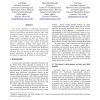Free Online Productivity Tools
i2Speak
i2Symbol
i2OCR
iTex2Img
iWeb2Print
iWeb2Shot
i2Type
iPdf2Split
iPdf2Merge
i2Bopomofo
i2Arabic
i2Style
i2Image
i2PDF
iLatex2Rtf
Sci2ools
HICSS
2005
IEEE
2005
IEEE
Evaluating Web-Based E-Government Services with a Citizen-Centric Approach
One of the challenges in delivering e-government services is to design the Web sites to make it easier for citizens to find desired information. However, little work is found to evaluate e-government services in this sense. In addition, current efforts on government Web site design mainly concentrate on Web site features that would enhance its usability, but few of them answers why some Web design is better than others to facilitate citizens’ information seeking. This paper aims to contribute to both aspects: it equips government agencies with a model that can not only evaluate their Web-based e-government services, but also helps them understand why their Web sites succeed or fail to help citizens find needed information. In addition to the model itself, instruments for applying this model are also developed.
Biometrics | E-government Services | Government Web Site | HICSS 2005 | System Sciences | Web Sites |
| Added | 24 Jun 2010 |
| Updated | 24 Jun 2010 |
| Type | Conference |
| Year | 2005 |
| Where | HICSS |
| Authors | Lili Wang, Stuart Bretschneider, Jon P. Gant |
Comments (0)

